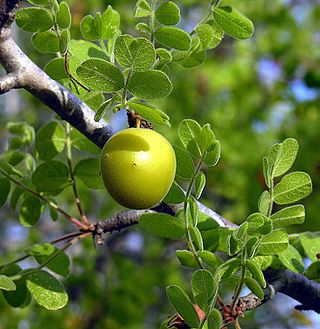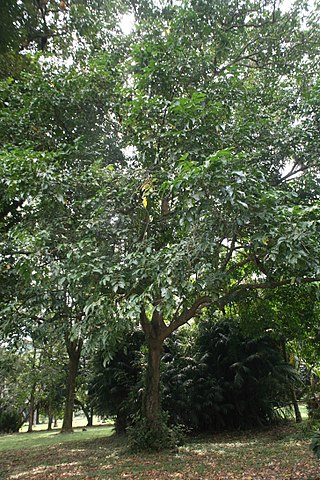
The Anacardiaceae, commonly known as the cashew family or sumac family, are a family of flowering plants, including about 83 genera with about 860 known species. Members of the Anacardiaceae bear fruits that are drupes and in some cases produce urushiol, an irritant. The Anacardiaceae include numerous genera, several of which are economically important, notably cashew, mango, Chinese lacquer tree, yellow mombin, Peruvian pepper, poison ivy, poison oak, sumac, smoke tree, marula and cuachalalate. The genus Pistacia is now included, but was previously placed in its own family, the Pistaciaceae.

The Burseraceae are a moderate-sized family of 17-19 genera and about 540 species of flowering plants. The actual numbers differ according to the time period in which a given source is written describing this family. The Burseraceae are also known as the torchwood family, the frankincense and myrrh family, or simply the incense tree family. The family includes both trees and shrubs, and is native to tropical regions of Africa, Asia, Australasia, and the Americas.

Astronium is a genus of flowering plants in the cashew family, Anacardiaceae. It is native to Central and South America.

Lithraea is a genus of three species of flowering plants in the cashew family, Anacardiaceae. It is native to Argentina, Bolivia, Brazil, Chile, Paraguay, and Uruguay. They are dioecious trees with poisonous sap that can induce contact dermatitis.

Metopium or poisonwood is a genus of flowering plants in the sumac family, Anacardiaceae. They are dioecious trees with poisonous sap that can induce contact dermatitis.

Anacardioideae is a subfamily of plants in the family Anacardiaceae.

Schinus polygama, the Hardee peppertree or Chilean pepper tree, is a species of plant in the family Anacardiaceae native to Argentina and Chile and naturalized in California.
Androtium is a monotypic genus of trees in the cashew or sumac family Anacardiaceae. It contains the single species Androtium astylum. The generic name Androtium is from the Greek meaning "male ear-lobe", referring to the shape of the lobe of the stamen. The specific epithet astylum is from the Latin meaning "without style", referring to the plant's ovary.
Fegimanra is a small genus of trees in the subfamily Anacardioideae of the cashew and sumac family Anacardiaceae. They grow naturally in west and west-central tropical Africa.

Holigarna is a genus of trees in the subfamily Anacardioideae of the cashew and sumac family Anacardiaceae. They grow naturally in India, Bangladesh and Indo-China. This is a poisonous tree; if contacted, it would irritate skin chemically and result in irreversible skin damage. Smoke from burning this wood is dangerously disabling.
Bonetiella is a monotypic genus of shrubs in the subfamily Anacardioideae of the cashew and sumac family Anacardiaceae. It contains the single species Bonetiella anomala, which is endemic to northern and central Mexico.
Campylopetalum is a monotypic genus of shrubs in the subfamily Anacardioideae of the cashew and sumac family Anacardiaceae. It contains the single species Campylopetalum siamense, which is endemic to northern Thailand.
Cardenasiodendron is a monotypic genus of dioecious trees in the subfamily Anacardioideae of the cashew and sumac family Anacardiaceae. It contains the single species Cardenasiodendron brachypterum, which is endemic to Bolivia.
Faguetia is a monotypic genus of trees in the subfamily Anacardioideae of the cashew and sumac family Anacardiaceae. It contains the single species Faguetia falcata, which is endemic to eastern Madagascar.
Laurophyllus is a monotypic genus of dioecious shrubs in the subfamily Anacardioideae of the cashew and sumac family Anacardiaceae. It contains the single species Laurophyllus capensis, which is endemic to the Eastern Cape province of South Africa. The species is found on wooded hillsides and by streams.
Mosquitoxylum is a monotypic genus of trees in the subfamily Anacardioideae of the cashew and sumac family Anacardiaceae. It contains the single species Mosquitoxylum jamaicense, which grows naturally from southern Mexico to Ecuador and also in Jamaica.
Orthopterygium is a monotypic genus of dioecious plants in the subfamily Anacardioideae of the cashew and sumac family Anacardiaceae. It contains the single species Orthopterygium huaucui, which is endemic to western Peru.

Cyrtocarpa is a genus of trees in the subfamily Spondiadoideae of the cashew and sumac family Anacardiaceae. Their habitat is dry forests to open arid areas. They grow naturally in Mexico and northern South America.
Pegia is a genus of plants in the subfamily Spondiadoideae of the cashew and sumac family Anacardiaceae.

Pseudospondias is a genus of plants in the subfamily Spondiadoideae of the cashew and sumac family Anacardiaceae. They grow as dioecious shrubs or trees and are found in forests of Sub-Saharan Africa.










